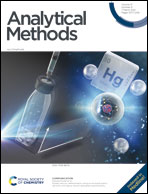Electropolymerization of poly(methylene blue) on flower-like nickel-based MOFs used for ratiometric electrochemical sensing of total polyphenolic content in chrysanthemum tea†
Abstract
A ratiometric electrochemical sensor for caffeic acid (CAE) detection was constructed using a glassy carbon electrode modified with poly(methylene blue) and flower-like nickel-based metal organic frameworks (PMB@Ni–TPA/GCE). The electrochemical behavior of CAE was investigated at the PMB@Ni–TPA/GCE, and was found to follow a two-electron, two-proton electrooxidation process. PMB was used as the internal reference probe, and Ni–TPA can enhance the electrochemical signals of both CAE and PMB. As the CAE concentration increases, the oxidation peak current of CAE is enhanced but that of PMB keeps almost unchanged. The oxidation peak current ratio between CAE and PMB recorded by differential pulse voltammetry changes linearly with CAE concentration over the range of 0.25–15.0 μM, with a detection limit of 0.2 μM. The proposed sensor was successfully employed to evaluate the total polyphenolic content as CAE equivalent in chrysanthemum tea, and the results were comparable with those given by the reference Folin–Ciocalteu spectrophotometry.



 Please wait while we load your content...
Please wait while we load your content...